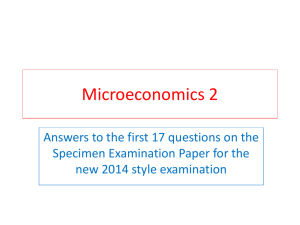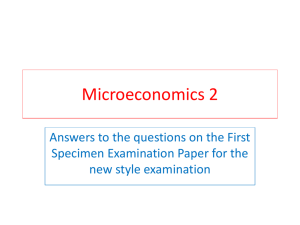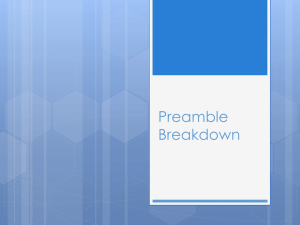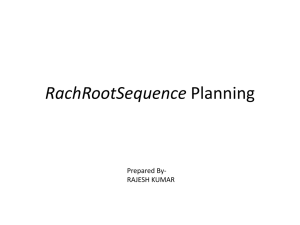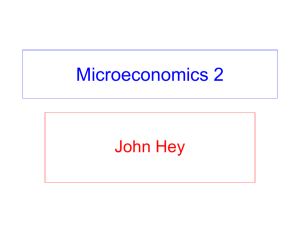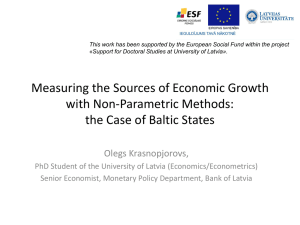Microeconomics
advertisement
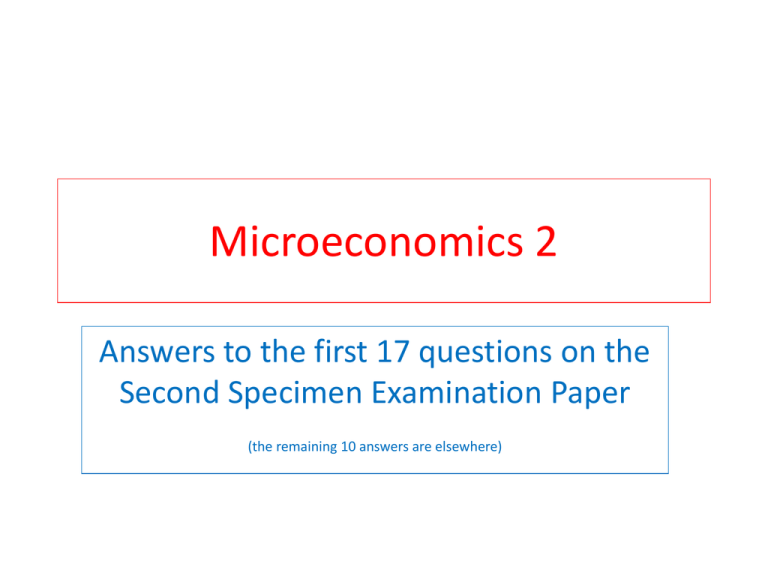
Microeconomics 2 Answers to the first 17 questions on the Second Specimen Examination Paper (the remaining 10 answers are elsewhere) Rules of examination • Please use the answer sheets attached to the examination paper. Students should not bring their own electronic calculators; standard university electronic calculators will be provided at each desk. To begin with pencil in the answers; at the end, ink them in. • There are 27 questions in sets of various sizes. Each set of questions is preceded by a preamble, which remains in force until the next preamble. Four marks are awarded for each correct answer and one mark will be deducted for each wrong answer. The resulting mark, denoted by x will be between -27 and 108. It will then be converted into a final mark for this module y using the formula y = (x+27)/1.35, which ensures that the final mark will lie between 0 and 100. • Detail of the examination structure is in the detailed description document on the Module site. • I will put this PowerPoint on the Module site next Monday. Preamble to and Questions 1 to 4 • Consider a market for a hypothetical good in which there are a number of buyers and sellers, each of which wants to buy or sell one unit of the good. There are 6 buyers and their reservation prices are 5, 11, 10, 6, 12 and 7. There are 5 sellers and their reservation prices are 9, 10, 5, 6 and 4. • Question 1: What is the maximum surplus realisable in the market? • Question 2: What is the maximum number of trades possible (not necessarily with the same price)? • Question 3: If the buyers grouped together and chose a single price which maximised their total buyer surplus, what price would they choose (assuming that any seller indifferent between selling and not selling actually sells)? • Question 4: If the sellers grouped together and chose a single price which maximised their total seller surplus, what price would they choose (assuming that any buyer indifferent between buying and not buying actually buys)? Answers to Questions 1 to 4 found by drawing demand and supply ‘curves’ Question 1: 18 Question 2: 5 Question 3: 6 Question 4: 10 Preamble to and Questions 5 and 6 • Consider an individual with quasi-linear preferences whose indifference curve between money (on the vertical axis) and the quantity of a DISCRETE good (on the horizontal axis) is as given in Figure 1 attached to this script. Suppose the individual starts with an endowment at the point marked X in the figure. Suppose there is a market in which the DISCRETE good can be sold or bought at a fixed price. Suppose the price at the moment is 32. (You might like to know that the equation of the curve is m = 60/q where m and q are the variables on the vertical and horizontal axes respectively.) • Question 5: State whether the individual will be a buyer or a seller and how many units he or she will buy or sell at this price. • Question 6: What will the individual's surplus be at this price? Answers to Questions 5 and 6 • • • • • • • • Starts at (3,20) (good, money). Price is 32. Cannot buy 2 – not enough money. Cannot buy 1 – not enough money. If does nothing surplus nothing. If sells 1 – moves to (2,52) surplus 22. If sells 2 – moves to (1,84) surplus 24. If sells 3 - ???? Hence sells 2 and has surplus 24. Preamble to and Questions 7 and 8 • Consider an individual with quasi-linear preferences whose indifference curves between money (on the vertical axis) and the quantity of a CONTINUOUS good (on the horizontal axis) are as given in Figure 2 attached to this script . Suppose the individual starts with an endowment at the point marked X in the figure. Suppose there is a market in which the CONTINUOUS good can be sold or bought at a fixed price. Also inserted in the figure are the budget lines for 4 different prices. Suppose the price is such that the individual's optimal decision is to buy 2 units. (You might like to know that the equation of the curve is m = 60/q where m and q are the variables on the vertical and horizontal axes respectively. • Question 7: What approximately is the price in the market? • Question 8: What approximately is the individual's surplus at this price? Answers to Questions 7 and 8 • • • • • • If buys two units moves to flattest budget line. This intersects the vertical axis at just over 27. Hence has a slope of –(27.2-20)/3 = - 2.4. Spends 4.8. So moves from (3,20) to (5,15.2). The original indifference curve m = 60/q passes through (5,12) an hence ends up 3.2 above it. • Hence the price is 2.4 and the surplus is 3.2. Preamble to and Questions 9 and 10 • Consider an individual whose preferences are either Perfect Substitutes, Perfect Complements or Cobb-Douglas with parameter a, allocating a given endowment between two goods whose prices are p and 1 respectively. The individual's endowments of the two goods are 15 and 7 respectively. In the first situation the price p of Good 1 was 0.5 and the individual chose to consume 14½ of Good 1 and 7¼ of Good 2. In the second situation the price p of Good 1 was 1 and the individual chose to consume 14⅔ of Good 1 and 7⅓ of Good 2. • Question 9: What are the individual's preferences? • Question 10: What is the value of the parameter a? Key results about demands (useful for questions 9 to 12) • With Perfect Substitute preferences (with parameter a)... • ...the Individual always spends all his or her income on one of the two goods, unless... • ... the price equals the parameter a. (If p>a then q1=0; if p<a then q2=0) • With Perfect Complement preferences (with parameter a)... • ...the ratio of the quantities (q2/q1) purchased is always equal to the parameter a. • With Cobb-Douglas preferences (with parameter a)... • ...the individual always spends a fraction a of his or her income on Good 1. Answers to Questions 9 and 10 • • • • Are prices different in the two situations? Yes (so?) Is the quantity purchased of either good zero? No – so cannot be Perfect Substitutes. Is the proportion of income spent on Good 1 in the two situations the same?: proportion 14½*½/(14½*½+7¼) =½ in 1; and proportion 14 ⅔ *1/(14 ⅔ *1+7⅓) = ⅔ in 2. • No – so cannot be Cobb-Douglas. • Is the ratio of quantities (q2/q1) the same in the two situations: 7¼/14½ = 1/2 and 7⅓ /14 ⅔ =1/2. • Yes - hence Perfect Complements with a=1/2. Preamble to and Questions 11 and 12 • Consider an individual whose preferences are either Perfect Substitutes, Perfect Complements or Cobb-Douglas with parameter a, allocating a given monetary income between two goods whose prices are p and 1 respectively. The individual's endowment of money is 117. In the first situation the price p of Good 1 was 2 and the individual chose to consume 10 of Good 1 and 97 of Good 2. In the second situation the price p of Good 1 was 3 and the individual chose to consume 0 of Good 1 and 117 of Good 2. • Question 11: What are the individual's preferences? • Question 12: What is the value of the parameter a? Answers to Questions 11 and 12 • • • • Are prices different in the two situations? Yes (so?) Is the quantity purchased of either good zero? Yes – in situation 2 – so it must be Perfect Substitutes. Now notice that in situation 1, the quantity of neither good is zero. • Hence in situation 1 the individual must be indifferent between all the points along the budget line (for otherwise would consume zero of some good). • To be indifferent, the slope of the budget line in situation 2 must be equal to the slope of the indifference ‘curve’/line. • Hence Perfect Substitutes with parameter 2. Preamble to and Questions 13 to 16 • Consider competitive exchange of two goods, Good 1 and Good 2, between two Individuals A and B. A starts with an endowment of 12 units of Good 1 and none of Good 2. B starts with an endowment of 12 units of Good 2 and none of Good 1. Individual A has Perfect Complement Preferences with a parameter 1. Individual B has Cobb-Douglas Preferences with a parameter 0.5. (In answering this question you should note a convention that we use here: in order for a situation to be termed a competitive equilibrium we require that both individuals are STRICTLY better off than with they were with their initial endowments.) • • • • Question 13: Determine whether a competitive equilibrium exists, and if so, determine the competitive equilibrium exchange rate. Question 14: If a competitive equilibrium exists, how many units of good 1 are exchanged? Question 15: If a competitive equilibrium exists, how many units of good 2 are exchanged? Question 16: Would dividing EQUALLY the initial endowments of the two goods be an efficient way of finally allocating the two goods to the two individuals? The simplest way is with an Edgeworth Box • Draw in the price-offer curves. • For PC it is easy. For PS it would help to draw in the indifference curves. • For CD make use of the fact that A has all of Good 1 and B all of Good 2. • Here B wants to keep 1/2 of his/her Good 2. • If the price-offer curves intersect inside the box at a point where both are better off then that is the competitive equilibrium. If not, not. Answers to Questions 13 to 16 • The competive exchange is at (6,6). • The price line from the endowment point (12,12) to (6,6) has slope 1. • The competitive exchange rate is therefore 1 for 1. • A gives up 6 of Good 1 for 6 of Good 2 • B gives up 6 of Good 2 for 6 of Good 1 • Diving equally at point (6,6) is efficient. • So answers are: 1 for 1; 6; 6; Yes Preamble to and Question 17 • Consider a perfectly competitive firm with a quadratic cost function C(q) = a + bq + cq2 where the parameters a, b and c are given below (note that the firm has to incur its fixed cost a whether it produces any output or not). Suppose that the given price for its output is 11. The value of a is 18, the value of b is 3, and the value of c is 1. • Question 17: What is its profit maximising (loss minimising) output? Answer to Question 17 • The cost function is C(q) = 18 + 3q + q2 • Hence Marginal Cost MC = 3 + 2q • The profit-maximising condition for a competitive (price-taking) firm is price = MC • The price = 11. • The condition implies 11 = 3 + 2q • So q = 4 • and, incidentally, • Profit =11*4 – (18 +3*4+42)= -2 That is the end of the answers to the first 17 questions on the second specimen examination paper • Go slow – there is plenty of time. • The questions are easy if you understand microeconomics. • They are difficult if you do not. • You cannot memorise answers. • You may want to memorise methods - but that is exactly what I have been trying to teach you. • Obviously this is a specimen – do look at the document detailed description on the site.
